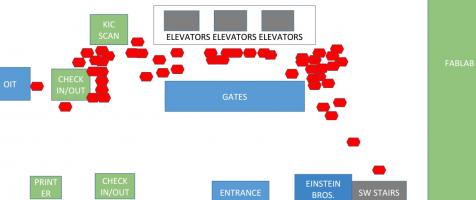
by Leni Matthews


by Leni Matthews
This is a brief report discussing some of the findings of LibQUAL report of 2015 compared with the Wayfinding project completed in 2016.
What is LibQUAL and Wayfinding?
LibQUAL, is a survey measuring libraries' user satisfaction based upon their responses to questions in three dimensions -- Affect of Service, Information Control and Library as Place. The Wayfinding project was research conducted in CEN Library to discover students' attitudes and ways they navigate the library to find resources. Both studies collected qualitative and quantitative data.
Findings
LibQUAL and the Wayfindng project implicate the need for library/staff assistance. Whether it is digital research help or finding resources in the library, users need help from knowledgeable staff.
LibQUAL Comments
One-third of LibQUAL comments referenced assistance with answering questions and finding resources (online or in-person). There is almost an equal amount of positive and critical comments, with positive comments slightly above. Positive comment:
"The library staff is very helpful. It is such as blessing."
Critical comments focus on knowledgeable employees.
"Student staff don't have adequate training to answer questions; the professional staff are difficult to locate for assistance."
"Roaming the stacks with a rough idea of the organizing principle behind the call numbers is also time consuming, but at least it's fun."
"Otherwise the building is a disgrace but the services are better. The assistance available varies a lot. Sometimes good sometimes nonexistent."
Wayfinding
According to the participants' ratings, they prefer to find resources on their own (explore) when navigating a space. They rated three ways of finding resources: asking, exploring and using signage. Library visitors want to be able to find resources on their own and the library should be able to assist the. Resources with signage, such as Check-out, were deemed easier to find than those resources without signage such as SPCO. Graphic 1 illustrates where participants slowed and stopped on the 1st floor of CEN Library. These "bump-points" are decision-making areas where we can begin to meet students' needs (to ask, explore or use signage).

Search Preferences: 19% ask 50% explore 28% signage
What we already know about our users
From the 2012 Population Studies research, we learned that students generally prefer an environment that has all of the amenities of home, without the distractions such as space to spread out their work, power sources for technology and the availability of food and drink were key. Having a safe environment were they cold secure their belongings for short periods of time, and facilities and resources that would accommodate their academic routine during the week.
Moving forward
LibQUAL and the Wayfinding data can inform us about where service points can be improved. They are starting points to address service and user needs: being available to answer questions fr users that prefer to ask for help, creating or improving signage for users that like to explore the library and use signs/maps. The Libraries' student employees can also give us critical information about how they and their friends use library services. More research is needed to find out specific service needs and how to deliver these needs. Service point locations, be it signage or staff, can be improved through training and proper placement of these services throughout the library.
Add new comment